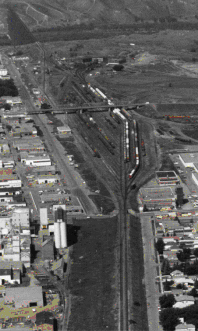
In May of 1905, Lethbridge wanted the C.P.R. to move its divisional rail center from Fort Macleod to Lethbridge. Lethbridge offered to provide the CPR with city land that would not be taxed for twenty years. The deal was that the C.P.R. would receive 48.6 hectares of city land and included access to 756 000 litres of city water daily. The C.P.R. accepted the city’s offer and then spent $50 000 on an union station, roundhouse, rail yards, machine shops, and freight sheds.

P19921007005-GP The C.P. Rail yards in Lethbridge prior to their relocation to Kipp in 1984.
Besides being good for the economy there were other benefits of having the rail yards in Lethbridge. For example, it led to the construction of the C.P.R. High Level Bridge, which has been a symbol of pride for the entire city. Many businesses came to the city because it was the divisional center for the C.P.R. This resulted in Lethbridge to change from a mining town to a commercial distribution centre. However, after World War II, the dependence on the rail service became less as highway transport became seen as more efficient. Although most grain products were still shipped by rail, the rail yards in the city no longer resulted in the economic benefits of earlier days.

Engine 8665 pulling a long line of freight cars along the line near Lethbridge.
In 1970 Marathon Realty announced that the C.P.R. intended to remove its track and marshaling yards by the end of decade. The federal government introduced legislation to help cover the cost of moving the rail lines. Lethbridge became the first small city to apply for these funds in May 1974. In 1977, Kipp was named as the new location of the rail yards. The city of Lethbridge re-zoned the old rail yards to allow for the construction of the Crowsnest Corridor freeway. By 1984, the rail yards were removed and construction begun on the new freeway.
The removal of the rail yards marked the end of an important 100 year relationship between the railway and Lethbridge. The railway was no longer the centre of the city’s economy and development. The only thing left to remind Lethbridge of its railway past is the High Level Bridge.
Previous Page | Exhibit Contents | Home | Navigation Information | Glossary | Curriculum Guide | Next Page
Copyright © 1996 Sir Alexander Galt Museum. All rights reserved.